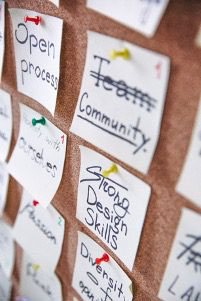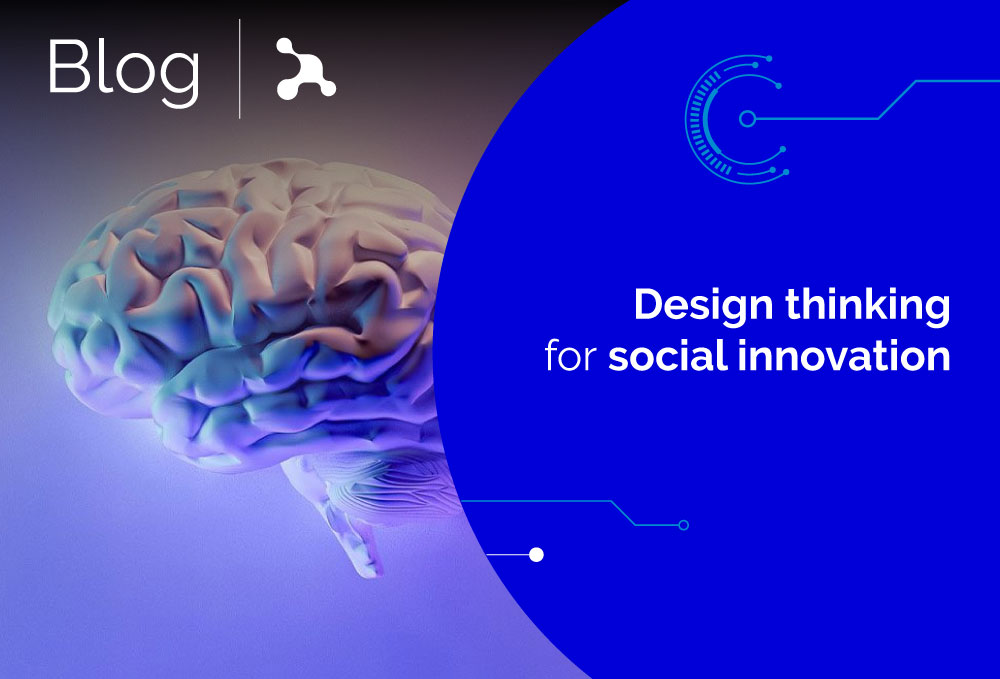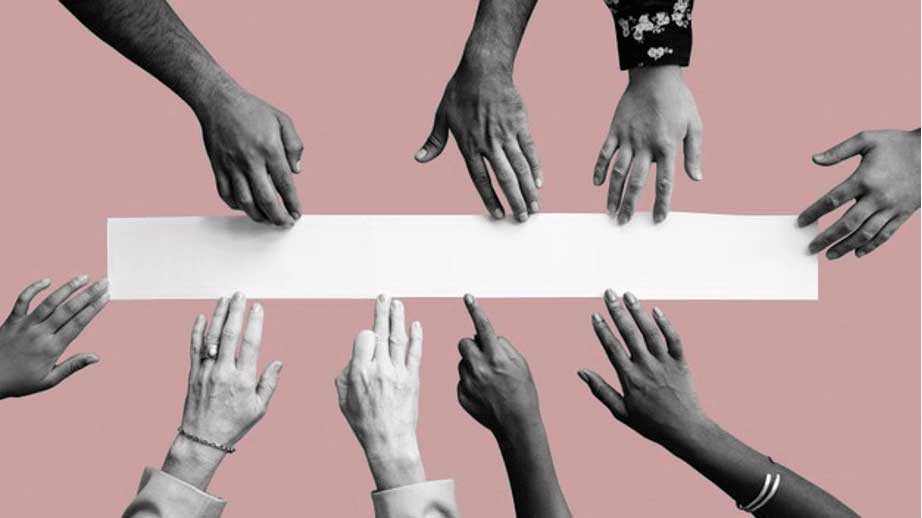All kinds of social challenges constantly arise in our current reality, changing circumstances that require specific actions and innovative solutions. The key to success lies in how we face these challenges and how we solve problems, finding opportunities to change experiences, services, and products in our day-to-day lives.
Design Thinking functions as a methodology that gathers precise tools to foster the development of novel projects that generate different experiences for human beings. Under this creative atmosphere, we manage to identify real needs of real people in different contexts.

Why Choose Design Thinking?
Being a methodology that FOCUSES ON THE HUMAN BEING AND THEIR EXPERIENCES, it is ideal for approaching and solving situations that involve understanding real needs, requiring a field of study and practice with a great creative impulse that cares about them. (Learn more about the Design Thinking methodology in the article: THE IMPACT OF DESIGN THINKING IN DIFFERENT INDUSTRIES)
These needs require systemic solutions that are based on a broad vision of consumer needs. The Design Thinking approach proves to be the best solution to encompass them.
Working in a multidisciplinary manner, Design Thinking highlights the value of teamwork that connects ideas from different areas of thought under a concrete methodology that results in a clear approach to the problem and the solution.
In this article, we will explore the importance of this role and its anatomy, all with the aim of raising awareness among organizations about its value and providing Developers with a basic guide to becoming one, as this is usually the next step in the evolutionary process of a Software Engineer dedicated to software development on their path to becoming a Software Architect.
Design for social innovation, a growing trend
From there emerges what is known as “Design for social innovation.” Empathetic and constructive, it seizes spaces of vulnerability to ground thoughts and design tools aimed at raising awareness among the population, addressing problems, and consolidating viable development structures through interaction and creative processes.
It allows us to generate essential values, reconnect with a research focus, remember the power of the visual, share knowledge, and build solutions that recognize voices and visions of different users, making use of available resources to change a specific reality and need.
That is why more and more companies, organizations, consultancies, and communities delve into the exploration of culture and innovation, solving and designing impactful experiences, services, and processes that can change the reality of those who need it most.
Some stages of the Design Thinking process
The work carried out through design with different communities allows us to identify issues with great opportunities for action and resolution. Always considering their vulnerability and the construction of new strategies to reintegrate them into society.
Finally, it is worth highlighting one of the main responsibilities of a technical leader: they have a daily goal that they must never forget, which is to provide continuous and proactive technical support to all developers on the team to ensure the success of each of them in the project.
1. Briefing and inspiration
Let’s remember that the focus of design methodologies for social work must follow a guideline of strategy and innovation centered on improving the quality of life for all people. That is why tools that allow visits, accompaniment, local work with communities, and documentation of stories to achieve a comprehensive view of the situation are of vital importance. This way, we can prioritize the action plan.
As a result, we manage to consolidate a clear and precise brief that allows the team to establish a starting point to create the project and the objectives to be achieved, such as costs, available resources, beneficiary population, etc. This is how the team should discover the needs of specific users through surveys, interviews, and focus groups. However, the best starting point is observing user experiences in a real context: farmers, vulnerable communities, and children (for more information, read the article: IUX: INCLUSIVE AND ACCESSIBLE DESIGN to discover the importance of understanding our users) while they carry out their daily tasks.

Dynamic activities, role-playing games, character creation, empathy maps, and co-creation sessions are strategic tools to carry out a conscious observation that ensures the design thinkers’ understanding of the roles in the community, as well as their relationships and interactions among stakeholders.
We can discover which everyday objects and experiences can serve to build a more effective and, in our case, sustainable service. We gain a comprehensive understanding of the community’s needs.
2. Opportunities and ideation
After observing and researching in the previous stages, the synthesis stage follows, where all the information seen and heard collected so far is transformed into crucial findings and insights that can lead to key opportunities for change. A compilation of possibilities and diverse perceptions about human behavior, key to creating new products, media, and services that create rich experiences to solve a need.
These possibilities and opportunities are discovered by a diverse team, individuals with unique capabilities and strengths from a specific field of knowledge, but passionate about empathy towards people and disciplines different from their own, constant exploration and curiosity, as well as experimentation and a desire for learning.
To ideate successfully, it is necessary to generate ideas without any filter. We seek the highest possible quantity, different, creative ideas that allow us to approach our challenge or problem in a different way than usual. Based on our findings and insights, we use strategies such as brainstorming or brainwriting. In these strategies, the team aligns with the problem and the discovered information and creates spaces for ideation and rapid idea generation. It is recommended to carry out ice-breaking exercises among participants and thus design fun and enriching sessions for the project.

When working with communities, it is crucial to design for their well-being. With the opportunities discovered previously, we create design possibilities or redesign of basic services that reduce conflicts, inconveniences, and re-victimization of our users. We propose and ensure the involvement of the community in every step of the process, raising awareness, learning, and replicating the importance of our proposal.
3. Prototyping, iteration, and implementation
It is time to make the idea tangible, bring it into the practical realm, where it will come to life and test our previous phases of the process. Let’s remember that Design Thinking is a methodology always oriented towards action, which is why our users ideally should have the ability to experience the proposals directly and not just conceptually.
Social innovation through design poses a challenge of working based on symbolic meanings that are essential for our users. Our proposals and projects must be thought out based on the sense of participation of our users, fostering positive relationships, personal development of all individuals, improving the community’s competencies and skills, and personal motivations and aspirations to achieve community goals.
That is why the project can be structured if we identify how users can become allies in the creation and development of the service or product, making it renewable and sustainable. As part of the proposal, we must build an ethnography that allows us to identify determining values in the process that the community goes through and what it expects to achieve.
This is how the best ideas from the previous phase are selected and transformed into more concrete action plans, which will become prototypes that are tested to reaffirm hypotheses and findings from the process. Creating prototypes is essential to validate components of a product or values of a service.
Once the prototypes are created, before implementing them in the context, we require iteration processes with the benefited users. With this step, we seek to find implementation challenges that have not been seen up to that point and ensure a reliable success of our experience, product, or service.
The above was a basic description of the anatomy of leadership, and before we continue, we must not forget a fundamental principle:
Conclusion
As we can see, the implementation of a culture of innovation, research, and Design Thinking will help us solve social problems and challenges, guide our ideas to viable proposals and strategies that serve the real world and generate positive results for people and communities in need, only with an investment of creativity, empathy, and effective inclusion of the population.
BIBLIOGRAPHICAL REFERENCES
(2009) Change by Design: How Design Thinking Transforms Organizations and Inspires Innovation, Tim Brown https://digitalcommons.uri.edu/cgi/viewcontent.cgi?article=1125&context=mgdr
(2010) Design thinking and social innovation, Standford social innovation review https://ssir.org/articles/entry/design_thinking_for_social_innovation#
(2020) Jornadas de diseño social, Asociación de diseñadores de la comunitat valenciana (ADCV)https://www.adcv.com/diseno-para-la-innovacion-social-y-diseno-social/
(2019) Usando el design thinking para que los niños y niñas transformen sus vidas, Opendmind consulting & design https://www.openmind-global.com/803-usando-el-design-thinking-para-que-los-ninos-y-ninas-transformen-sus-vidas
La generación del reto creativo en la fase idear, Design thinking España https://xn--designthinkingespaa-d4b.com/idear-tercera-fase-design-thinking
REFERENCIAS MULTIMEDIA
https://www.pexels.com/es-es/foto/notas-a-bordo-3782226/ Fotografía 1
https://www.pexels.com/photo/mountains-man-people-woman-8262089/ Fotografía 4
https://www.freepik.es/foto-gratis/primer-plano-diversas-personas-uniendo-sus-manos_12193015.htm#page=1&query=diversity&position=18 Fotografía 5and inspiration





